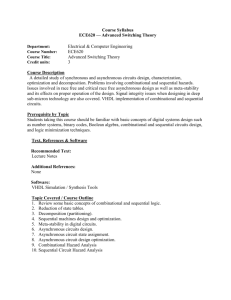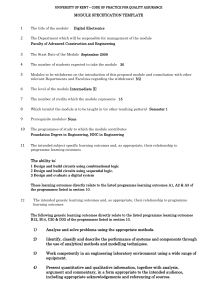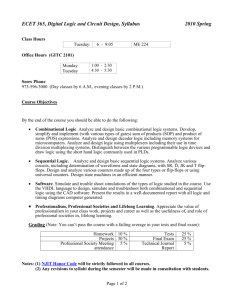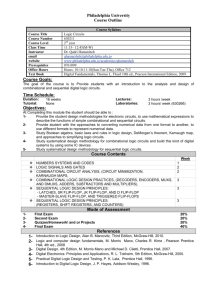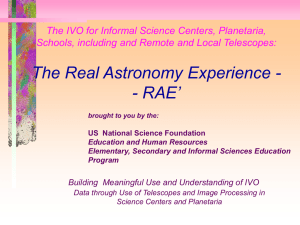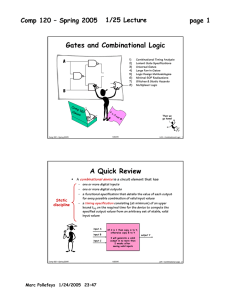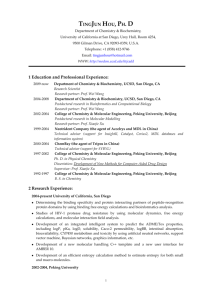COMP 2130
advertisement
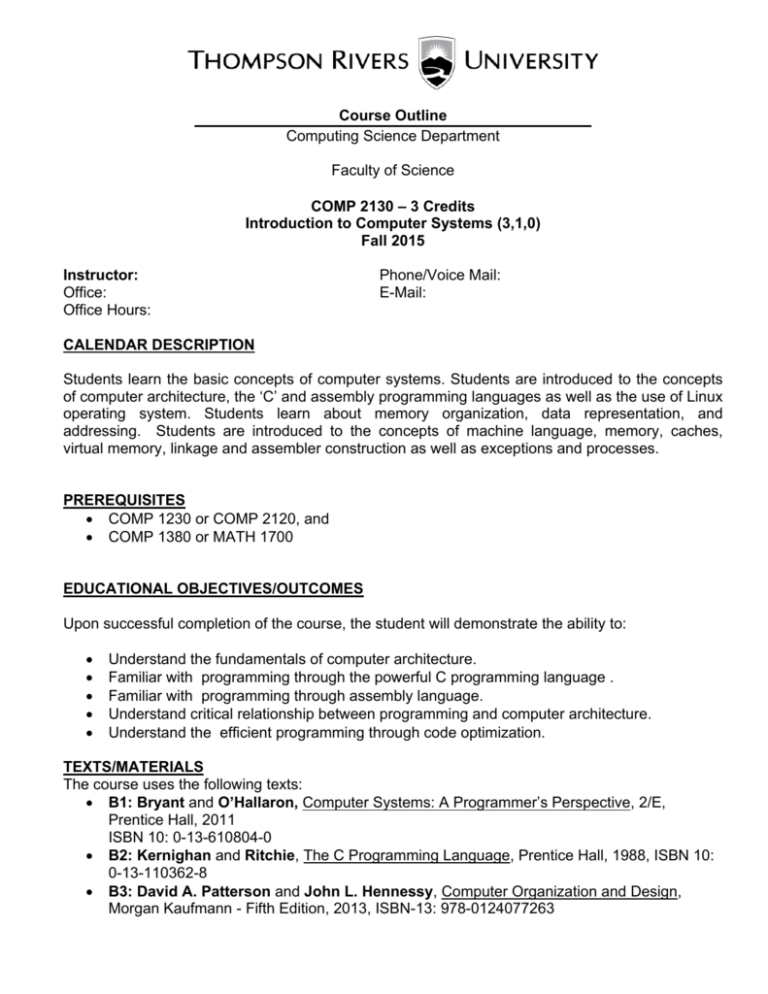
Course Outline Computing Science Department Faculty of Science COMP 2130 – 3 Credits Introduction to Computer Systems (3,1,0) Fall 2015 Instructor: Office: Office Hours: Phone/Voice Mail: E-Mail: CALENDAR DESCRIPTION Students learn the basic concepts of computer systems. Students are introduced to the concepts of computer architecture, the ‘C’ and assembly programming languages as well as the use of Linux operating system. Students learn about memory organization, data representation, and addressing. Students are introduced to the concepts of machine language, memory, caches, virtual memory, linkage and assembler construction as well as exceptions and processes. PREREQUISITES COMP 1230 or COMP 2120, and COMP 1380 or MATH 1700 EDUCATIONAL OBJECTIVES/OUTCOMES Upon successful completion of the course, the student will demonstrate the ability to: Understand the fundamentals of computer architecture. Familiar with programming through the powerful C programming language . Familiar with programming through assembly language. Understand critical relationship between programming and computer architecture. Understand the efficient programming through code optimization. TEXTS/MATERIALS The course uses the following texts: B1: Bryant and O’Hallaron, Computer Systems: A Programmer’s Perspective, 2/E, Prentice Hall, 2011 ISBN 10: 0-13-610804-0 B2: Kernighan and Ritchie, The C Programming Language, Prentice Hall, 1988, ISBN 10: 0-13-110362-8 B3: David A. Patterson and John L. Hennessy, Computer Organization and Design, Morgan Kaufmann - Fifth Edition, 2013, ISBN-13: 978-0124077263 SYLLABUS - Lecture & Lab Topics: Course Topics 1. Basic concepts of digital systems: 1.1 Introduction 1.2 Gates, Truth Tables, and Logic Equations 1.3 Combinational Logic 1.4 Using HW Description Language 1.5 Clocks 1.6 Memory Elements 1.7 SRAMs and DRAMs 1.8 FSM 2. Computer Abstraction and Technology 2.1 Introduction 2.2 The compilation system 2.3 Computer Architecture and Processor Technology 2.3 How OS manages HW 3. Introduction to Linux OS and C Language 3.1 Getting Familiar with Linux 3.2 Introduction to C Programming 3.3 Advanced C Programming 4. Memory Organization, Data representation, and Addressing 4.1 Information Storage 4.2 Integer Representation and Floating Point Numbers 5. Basics of Architecture, Machine Code 5.1 A Historical Perspective 5.2 Program Encodings 5.3 Data Formats 6. Machine Level Programming 6.1 Arithmetic and Logical Operations 6.2 Control 6.3 Procedures 6.4 Arrays 7. Memory and Caches 7.1 Storage Technologies 7.2 Locality 7.3 The Memory Hierarchy 7.4 Cache Memories 7.5 Writing Cache-friendly Code 7.6 Putting It Together: The Impact of Caches on Program Performance 2 Reference to Text Book* Duration** B3-Appendix B.1 B3-Appendix B.2 B3-Appendix B.3 B3-Appendix B.4 B3-Appendix B.7 B3-Appendix B.8 B3-Appendix B.9 B3-Appendix B.10 1.5 weeks B3-Chapter 1:1.1-1.2 1 week B3-Chapter 1:1.3 & B1-Chapter 1:1.2-1.3 B3- Chapter 1:1.41.5 & B1-Chapter 1:1.4-1.6 B1-Chapter 1:1.7-1.8 Instructor notes B2-Chapter 1-4 B2-Chapter 5-8 2.5 weeks B1-Chapter 2:2.1 B1-Chapter 2:2.2&2.4 1 week B1-Chapter 3:3.1 B1-Chapter 3:3.2 B1-Chapter 3:3.3 1 week B1-Chapter 3:3.5 B1-Chapter 3:3.6 B1-Chapter 3:3.7 B1-Chapter 3:3.8 1 week B1-Chapter 6:6.1 B1-Chapter 6:6.2 B1-Chapter 6:6.3 B1-Chapter 6:6.4 B1-Chapter 6:6.5 B1-Chapter 6:6.6 2 week 8. Linking 8.1 Compiler Drivers 8.2 Static Linking 8.3 Object Files 8.4 Relocatable Object Files 8.5 Symbols and Symbol Tables 8.6 Symbol Resolution 8.7 Relocation 8.8 Executable Object Files 8.9 Loading Executable Object Files 8.10 Dynamic Linking with Shared Libraries 8.11 Loading and Linking Shared Libraries from Applications 9. Exceptions and Processes 9.1 Exceptions 9.2 Processes 9.3 System Call Error Handling 9.4 Process Control 10. Virtual Memory 10.1 Physical and Virtual Addressing 10.2 Address Spaces 10.3 VM as a Tool for Caching 10.4 VM as a Tool for Memory Management * This is just a reference to the reading material. ** Tentative duration. Lab Topics Introduction to Linux & Setting up the VM C Programming Labs Basic assembly language programming Advanced C Programming Labs Testing and Debugging 3 B1-Chapter 7:7.1 B1-Chapter 7:7.2 B1-Chapter 7:7.3 B1-Chapter 7:7.4 B1-Chapter 7:7.5 B1-Chapter 7:7.6 B1-Chapter 7:7.7 B1-Chapter 7:7.8 B1-Chapter 7:7.9 B1-Chapter 7:7.10 B1-Chapter 7:7.11 2 week B1-Chapter 8:8.1 B1-Chapter 8:8.2 B1-Chapter 8:8.3 B1-Chapter 8:8.4 0.5 week B1-Chapter 9:9.1 B1-Chapter 9:9.2 B1-Chapter 9:9.3 B1-Chapter 9:9.4 0.5 week ACM / IEEE Knowledge Area Coverage IEEE Knowledge Areas that contain topics and learning outcomes covered in the course Knowledge Area AR/Digital Logic and Digital Systems AR/Machine Level Representation of Data AR/Assembly Level Machine Organization AR/Memory System Organization and Architecture AR/Interfacing and Communication PL/Basic Type Systems SF/Computational Paradigms SF/State and State Machines SF/Evaluation Total Hours of Coverage 3 3 6 3 1 2.5 3 3 3 IEEE Body of Knowledge coverage KA Knowledge Unit Topics Covered AR Digital Logic and Digital Systems • Overview and history of computer architecture • Combinational vs. sequential logic/Field programmable gate arrays as a fundamental combinational + sequential logic building block • Multiple representations/layers of interpretation (hardware is just another layer) • Computer-aided design tools that process hardware and architectural representations • Register transfer notation/Hardware Description Language (Verilog/VHDL) • Physical constraints (gate delays, fanin, fan-out, energy/power) 4 T1 hou rs 0 T2 hou rs 3 Electiv e hours 0 KA Knowledge Unit Topics Covered AR AR/Machine Level Representation of Data AR AR/Assembly Level Machine Organization AR AR/Memory System Organization and Architecture AR AR/Interfacing and Communication • Bits, bytes, and words • Numeric data representation and number bases • Fixed- and floating-point systems • Signed and twos-complement representations • Representation of non-numeric data (character codes, graphical data) • Representation of records and arrays • Basic organization of the von Neumann machine • Control unit; instruction fetch, decode, and execution • Instruction sets and types (data manipulation, control, I/O) • Assembly/machine language programming • Instruction formats • Addressing modes • Subroutine call and return mechanisms (cross-reference PL/Language Translation and Execution) • I/O and interrupts • Heap vs. Static vs. Stack vs. Code segments • Shared memory multiprocessors/multicore organization • Storage systems and their technology • Memory hierarchy: importance of temporal and spatial locality • Main memory organization and operations • Latency, cycle time, bandwidth, and interleaving • Cache memories (address mapping, block size, replacement and store policy) • Multiprocessor cache consistency/Using the memory system for inter-core synchronization/atomic memory operations • Virtual memory (page table, TLB) • Fault handling and reliability • Error coding, data compression, and data integrity (cross-reference SF/Reliability through Redundancy) • I/O fundamentals: handshaking, buffering, programmed I/O, interrupt-driven I/O • Interrupt structures: vectored and 5 T1 hou rs 0 T2 hou rs 3 Electiv e hours 0 0 6 0 0 3 0 0 1 0 prioritized, interrupt acknowledgment • External storage, physical organization, and drives • Buses: bus protocols, arbitration, directmemory access (DMA) • Introduction to networks: communications networks as another layer of remote access PL SF PL/Basic Type Systems SF/Computational Paradigms o type as a set of values together with a set of operations o Primitive types (e.g., numbers, Booleans) o Compound types built from other types (e.g., records, unions, arrays, lists, functions, references) • Association of types to variables, arguments, results, and fields • Type safety and errors caused by using values inconsistently given their intended types • Goals and limitations of static typing o Eliminating some classes of errors without running the program o Undecidability means static analysis must conservatively approximate program behavior Generic types (parametric polymorphism) o Definition o Use for generic libraries such as collections o Comparison with ad hoc polymorphism (overloading) and subtype polymorphism • Complementary benefits of static and dynamic typing o Errors early vs. errors late/avoided Enforce invariants during code development and code maintenance vs. postpone typing decisions while prototyping and conveniently allow flexible coding patterns such as heterogeneous collections o Avoid misuse of code vs. allow more code reuse o Detect incomplete programs vs. allow incomplete programs to run • Basic building blocks and components of a computer (gates, flip-flops, registers, interconnections; 6 0.5 2 0 3 0 0 SF SF/State and State Machines SF SF/Evaluation Datapath + Control + Memory) • Hardware as a computational paradigm: Fundamental logic building blocks; Logic expressions, minimization, sum of product forms • Application-level sequential processing: single thread • Simple application-level parallel processing: request level (web services/client-server/distributed), single thread per server, multiple threads with multiple servers • Basic concept of pipelining, overlapped processing stages • Basic concept of scaling: going faster vs. handling larger problems • Digital vs. Analog/Discrete vs. Continuous Systems • Simple logic gates, logical expressions, Boolean logic simplification • Clocks, State, Sequencing • Combinational Logic, Sequential Logic, Registers, Memories • Computers and Network Protocols as examples of state machines • Performance figures of merit • Workloads and representative benchmarks, and methods of collecting and analyzing performance figures of merit • CPI (Cycles per Instruction) equation as tool for understanding tradeoffs in the design of instruction sets, processor pipelines, and memory system organizations. • Amdahl’s Law: the part of the computation that cannot be sped up limits the effect of the parts that can 7 3 0 0 3 0 0

